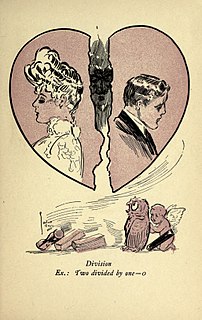Re Dennis [1996] Ch 80 is an English land law case, concerning co-ownership of land.
Re Dennis [1996] Ch 80 is an English land law case, concerning co-ownership of land.
Mr and Mrs Dennis were joint tenants. He failed to comply with a bankruptcy notice, an act of bankruptcy. Then his wife died. Then he was declared bankrupt. There was no secured lending affecting their house (mortgage) to which the wife had assented. The question in law was whether the act of bankruptcy terminated (severed) the joint tenancy between the couple; if so then the husband's trustees would not receive automatically the wife's share, instead her Will would be free to allocate the property as she saw fit (or if she had died intestate, the Intestacy Rules would prevail).
Held, under the Bankruptcy Act 1914, severance occurred at the date of the act of bankruptcy, so on her death the wife was a tenant in common with a half share and that passed to their children. Had a joint tenancy continued then the bankrupt's trustees would have acquired her share to consider in accordance with the bankruptcy rules.
Property law is the area of law that governs the various forms of ownership in real property (land) and personal property. Property refers to legally protected claims to resources, such as land and personal property, including intellectual property. Property can be exchanged through contract law, and if property is violated, one could sue under tort law to protect it.
Escheat is a common law doctrine that transfers the real property of a person who has died without heirs to the Crown or state. It serves to ensure that property is not left in "limbo" without recognized ownership. It originally applied to a number of situations where a legal interest in land was destroyed by operation of law, so that the ownership of the land reverted to the immediately superior feudal lord.
In common law, a deed is any legal instrument in writing which passes, affirms or confirms an interest, right, or property and that is signed, attested, delivered, and in some jurisdictions, sealed. It is commonly associated with transferring (conveyancing) title to property. The deed has a greater presumption of validity and is less rebuttable than an instrument signed by the party to the deed. A deed can be unilateral or bilateral. Deeds include conveyances, commissions, licenses, patents, diplomas, and conditionally powers of attorney if executed as deeds. The deed is the modern descendant of the medieval charter, and delivery is thought to symbolically replace the ancient ceremony of livery of seisin.
In property law, a concurrent estate or co-tenancy is any of various ways in which property is owned by more than one person at a time. If more than one person owns the same property, they are commonly referred to as co-owners. Legal terminology for co-owners of real estate is either co-tenants or joint tenants, with the latter phrase signifying a right of survivorship. Most common law jurisdictions recognize tenancies in common and joint tenancies.
Courtesy tenure is the legal term denoting the life interest which a widower may claim in the lands of his deceased wife, under certain conditions. The tenure relates only to those lands of which his wife was in her lifetime actually seised and not therefore to an estate of inheritance.

English trust law concerns the protection of assets, usually when they are held by one party for another's benefit. Trusts were a creation of the English law of property and obligations, and share a subsequent history with countries across the Commonwealth and the United States. Trusts developed when claimants in property disputes were dissatisfied with the common law courts and petitioned the King for a just and equitable result. On the King's behalf, the Lord Chancellor developed a parallel justice system in the Court of Chancery, commonly referred as equity. Historically, trusts have mostly been used where people have left money in a will, or created family settlements, charities, or some types of business venture. After the Judicature Act 1873, England's courts of equity and common law were merged, and equitable principles took precedence. Today, trusts play an important role in financial investment, especially in unit trusts and in pension trusts. Although people are generally free to set the terms of trusts in any way they like, there is growing legislation to protect beneficiaries or regulate the trust relationship, including the Trustee Act 1925, Trustee Investments Act 1961, Recognition of Trusts Act 1987, Financial Services and Markets Act 2000, Trustee Act 2000, Pensions Act 1995, Pensions Act 2004 and Charities Act 2011.

Street v Mountford[1985] UKHL 4 is an English land law case from the House of Lords. It set out principles to determine whether someone who occupied a property had a tenancy, or only a licence. This mattered for the purpose of statutory tenant rights to a reasonable rent, and had a wider significance as a lease had "proprietary" status and would bind third parties.

Errington v Wood[1951] EWCA Civ 2 is an English contract law and English land law judicial decision of the Court of Appeal concerning agreement and the right to specific performance of an assurance that is relied on.

English land law is the law of real property in England and Wales. Because of its heavy historical and social significance, land is usually seen as the most important part of English property law. Ownership of land has its roots in the feudal system established by William the Conqueror after 1066, and with a gradually diminishing aristocratic presence, now sees a large number of owners playing in an active market for real estate. The modern law's sources derive from the old courts of common law and equity, along with legislation such as the Law of Property Act 1925, the Settled Land Act 1925, the Land Charges Act 1972, the Trusts of Land and Appointment of Trustees Act 1996 and the Land Registration Act 2002. At its core, English land law involves the acquisition, content and priority of rights and obligations among people with interests in land. Having a property right in land, as opposed to a contractual or some other personal right, matters because it creates privileges over other people's claims, particularly if the land is sold on, the possessor goes insolvent, or when claiming various remedies, like specific performance, in court.
Borland’s Trustee v Steel Brothers & Co Ltd [1901] 1 Ch 279 is a UK company law case, concerning the enforceability of a company's constitution and the nature of a company share. It is also one of the rare exceptions to the rule that a transfer of assets which only takes effect upon a person's bankruptcy is normally void.

Belchier v Parsons (1754) 96 ER 908 is an English trusts law case, which stands as one of the earliest formulations of the prudent person rule.

Chhokar v Chhokar [1984] FLR 313 is an English land law case concerning constructive trusts law and widening the natural meaning of "actual occupation". The facts of the case showed an intention to do a woman out of her occupational interest in a matrimonial home, as the new co-owner buying his share from the husband knew of her situation from the outset and wished to resell the property. The court confirmed in these exact circumstances her interest was overriding at the time when she was in hospital and it was a constructive trust.

Williams v Hensman (1861) is an English trusts law case.

Re Draper’s Conveyance [1967] is an English land law case, concerning co-ownership of land.

Harris v Goddard [1983] 3 All ER 242 is an English land law and matrimonial law case, concerning co-owned land between spouses and finding as to the effect of a divorce petition.

Kinch v Bullard [1998] 4 All ER 650 is an English land law case, concerning co-ownership of land and an act of severance of a joint tenancy, whether caught by the deemed-delivered provisions of the common law postal rule.

Re K [1985] Ch 180 is an English land law case of acts of severance of a joint tenancy.

Re Citro [1991] Ch 142 is an English land law and bankruptcy law case, concerning co-ownership of land, and an order for possession on bankruptcy of one co-owner.

National Provincial Bank Ltd v Ainsworth [1965] is an English land law and family law case, concerning the quality of a person's interest in a home when people live together, as well as licenses in land.

Binions v Evans[1972] EWCA Civ 6 is an English land law and English trusts law case, concerning a constructive trust of land which will often be irrevocable whilst the occupier is in occupation as opposed to a licence to occupy — and/or a tenancy at will which is similar save that without transfer of the underlying property it can be revoked without cause. The case hinged on the fact there was an agreement specifying the existing occupier was to remain.